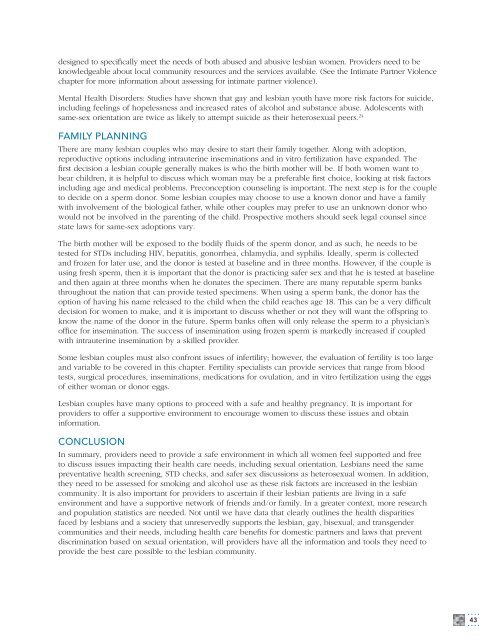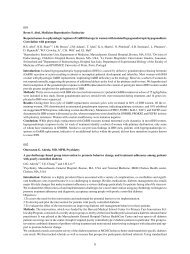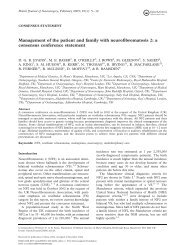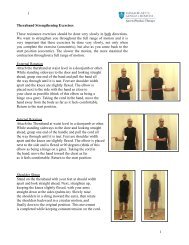from exposure to their partner’s bodily fluids. Sex between women includes digital (finger/hand) to genitalexposure, oral to genital exposure, and genital to genital exposure. Thus, a woman can protect herself fromher partner’s bodily fluids during digital to genital c<strong>on</strong>tact by using latex gloves or latex finger cots. For oralto genital protecti<strong>on</strong>, women can use a latex dental dam, double layered plastic wrap, or the Reality femalec<strong>on</strong>dom to cover the genital area. Women must not partake in oral to genital c<strong>on</strong>tact if either pers<strong>on</strong> has alesi<strong>on</strong> <strong>on</strong> the mouth or labia. As oil-based lubricants can breakdown the latex, <strong>on</strong>ly water-based lubricantsmust be used. Also, if women use sex toys, such as vibrators or dildos, it should be covered with latexc<strong>on</strong>doms or gloves and rinsed with a diluted (1 to 10) bleach/soapy water soluti<strong>on</strong> between usage.HEALTH RISKSCancers: As most cancer registries do not gather informati<strong>on</strong> <strong>on</strong> sexual orientati<strong>on</strong>, it is unknown whetheror not lesbians are at increased risk for various forms of cancer. However, as menti<strong>on</strong>ed earlier, individuallifestyle choices of a lesbian may increase her risk for breast cancer. The Women’s Health Initiative, the firstnati<strong>on</strong>al populati<strong>on</strong>-based research to include sexual orientati<strong>on</strong>, has shown that lesbians more often usedalcohol and cigarettes, thus increasing their risk for liver disease, lung cancer, and cardiovascular disease.Lesbians also displayed other risk factors that may increase their risk for reproductive cancers. 11 These riskfactors include traditi<strong>on</strong>ally less childbearing and ensuing breast-feeding, which decrease the risks of breast,ovarian, and uterine cancer. The lesbian community also has less usage of oral c<strong>on</strong>traceptives. Given thatoral c<strong>on</strong>traceptives decrease the risks of ovarian and uterine cancer, the majority of the lesbian communityhas not had the benefit of this protective effect. 19,20 Certainly, heterosexual women who have not hadchildren or used oral c<strong>on</strong>traceptives may have the same underlying risk factor, but lesbians face manybarriers to quality health <strong>care</strong> that can prevent or delay diagnosis.Obesity: The Women’s Health Initiative also suggests that a greater proporti<strong>on</strong> of lesbians are above theoverweight threshold when Body Mass Index (BMI= 27) is calculated (52.3% of lifetime lesbians comparedto 45.8% of heterosexual women). 11 Higher BMIs increase the risk for cardiovascular disease, jointproblems, gallst<strong>on</strong>es, and diabetes.Chr<strong>on</strong>ic Stress: Lesbians may experience chr<strong>on</strong>ic stress from homophobic discriminati<strong>on</strong>. The process of“coming out” is complicated and stressful for many lesbians. There is the fear of losing family, friends, andemployment. There is also the fear for <strong>on</strong>e’s safety. This stress can lead to use of alcohol and cigarettes,which are behaviors more prominent am<strong>on</strong>g lesbians. Chr<strong>on</strong>ic stress can lead to medical problems such asdepressi<strong>on</strong>. Screening for support networks may help to assess a patient’s level of coping skills and resources.(See the Mental Health chapter for more informati<strong>on</strong> <strong>on</strong> assessment of support networks and resources).Intimate Partner Violence: Prec<strong>on</strong>ceived stereotypes of violence within lesbian relati<strong>on</strong>ships may leadto decreased screening and lack of support for lesbians who are experiencing same-sex intimate partnerviolence (IPV). Even within the lesbian community there is denial about the prevalence of IPV, as thereis often a sense of pride in the ability to maintain equal partnerships and a fear of further stigmatizati<strong>on</strong> ifthis informati<strong>on</strong> is shared in heterosexual society. The similar sizes of the same-sex partners in many casesoften makes health <strong>care</strong> providers and law enforcement doubt the truth of the violence, as it c<strong>on</strong>flicts withgenerally held noti<strong>on</strong>s of an aggressor being of a greater size than the partner.Studies <strong>on</strong> same-sex IPV are limited by sample size but have borne out that IPV does occur in same-sexrelati<strong>on</strong>ships both with lesbians and gay men. Most studies have shown that 30-40% of lesbians report at least<strong>on</strong>e relati<strong>on</strong>ship with a same-sex partner in which she experienced an episode of IPV. These episodes rangedfrom slapping, shoving, and pushing, to beatings and assaults with weap<strong>on</strong>s. 21,22 Lesbians may not <strong>on</strong>ly be ina current relati<strong>on</strong>ship with IPV, but may also have been a victim of IPV in previous relati<strong>on</strong>ships. Accordingto the Nati<strong>on</strong>al Violence Against Women Survey published in July 2000, am<strong>on</strong>g women in current same-sexcohabitati<strong>on</strong> relati<strong>on</strong>ships, 39.2% reported a history of IPV at some point in their lives as compared with20.3% of women in current opposite-sex cohabitati<strong>on</strong>. 23 Of the women in same-sex relati<strong>on</strong>ships who werevictims of IPV in the past, 30.4% had been victimized by men while 11.4% had been victimized by women.As with heterosexual women, a lesbian in an abusive situati<strong>on</strong> with a partner may face discriminati<strong>on</strong>, aloss of pers<strong>on</strong>al safety, and potential loss of income and children. Domestic violence agencies serve bothheterosexual and lesbian women; however, there may be programs at LGBT community-based agencies42
designed to specifically meet the needs of both abused and abusive lesbian women. Providers need to beknowledgeable about local community resources and the services available. (See the Intimate Partner Violencechapter for more informati<strong>on</strong> about assessing for intimate partner violence).Mental Health Disorders: Studies have shown that gay and lesbian youth have more risk factors for suicide,including feelings of hopelessness and increased rates of alcohol and substance abuse. Adolescents withsame-sex orientati<strong>on</strong> are twice as likely to attempt suicide as their heterosexual peers. 24FAMILY PLANNINGThere are many lesbian couples who may desire to start their family together. Al<strong>on</strong>g with adopti<strong>on</strong>,reproductive opti<strong>on</strong>s including intrauterine inseminati<strong>on</strong>s and in vitro fertilizati<strong>on</strong> have expanded. Thefirst decisi<strong>on</strong> a lesbian couple generally makes is who the birth mother will be. If both women want tobear children, it is helpful to discuss which woman may be a preferable first choice, looking at risk factorsincluding age and medical problems. Prec<strong>on</strong>cepti<strong>on</strong> counseling is important. The next step is for the coupleto decide <strong>on</strong> a sperm d<strong>on</strong>or. Some lesbian couples may choose to use a known d<strong>on</strong>or and have a familywith involvement of the biological father, while other couples may prefer to use an unknown d<strong>on</strong>or whowould not be involved in the parenting of the child. Prospective mothers should seek legal counsel sincestate laws for same-sex adopti<strong>on</strong>s vary.The birth mother will be exposed to the bodily fluids of the sperm d<strong>on</strong>or, and as such, he needs to betested for STDs including HIV, hepatitis, g<strong>on</strong>orrhea, chlamydia, and syphilis. Ideally, sperm is collectedand frozen for later use, and the d<strong>on</strong>or is tested at baseline and in three m<strong>on</strong>ths. However, if the couple isusing fresh sperm, then it is important that the d<strong>on</strong>or is practicing safer sex and that he is tested at baselineand then again at three m<strong>on</strong>ths when he d<strong>on</strong>ates the specimen. There are many reputable sperm banksthroughout the nati<strong>on</strong> that can provide tested specimens. When using a sperm bank, the d<strong>on</strong>or has theopti<strong>on</strong> of having his name released to the child when the child reaches age 18. This can be a very difficultdecisi<strong>on</strong> for women to make, and it is important to discuss whether or not they will want the offspring toknow the name of the d<strong>on</strong>or in the future. Sperm banks often will <strong>on</strong>ly release the sperm to a physician’soffice for inseminati<strong>on</strong>. The success of inseminati<strong>on</strong> using frozen sperm is markedly increased if coupledwith intrauterine inseminati<strong>on</strong> by a skilled provider.Some lesbian couples must also c<strong>on</strong>fr<strong>on</strong>t issues of infertility; however, the evaluati<strong>on</strong> of fertility is too largeand variable to be covered in this chapter. Fertility specialists can provide services that range from bloodtests, surgical procedures, inseminati<strong>on</strong>s, medicati<strong>on</strong>s for ovulati<strong>on</strong>, and in vitro fertilizati<strong>on</strong> using the eggsof either woman or d<strong>on</strong>or eggs.Lesbian couples have many opti<strong>on</strong>s to proceed with a safe and healthy pregnancy. It is important forproviders to offer a supportive envir<strong>on</strong>ment to encourage women to discuss these issues and obtaininformati<strong>on</strong>.CONCLUSIONIn summary, providers need to provide a safe envir<strong>on</strong>ment in which all women feel supported and freeto discuss issues impacting their health <strong>care</strong> needs, including sexual orientati<strong>on</strong>. Lesbians need the samepreventative health screening, STD checks, and safer sex discussi<strong>on</strong>s as heterosexual women. In additi<strong>on</strong>,they need to be assessed for smoking and alcohol use as these risk factors are increased in the lesbiancommunity. It is also important for providers to ascertain if their lesbian patients are living in a safeenvir<strong>on</strong>ment and have a supportive network of friends and/or family. In a greater c<strong>on</strong>text, more researchand populati<strong>on</strong> statistics are needed. Not until we have data that clearly outlines the health disparitiesfaced by lesbians and a society that unreservedly supports the lesbian, gay, bisexual, and transgendercommunities and their needs, including health <strong>care</strong> benefits for domestic partners and laws that preventdiscriminati<strong>on</strong> based <strong>on</strong> sexual orientati<strong>on</strong>, will providers have all the informati<strong>on</strong> and tools they need toprovide the best <strong>care</strong> possible to the lesbian community.43
- Page 1 and 2: A PROVIDER’S HANDBOOKONCULTURALLY
- Page 3 and 4: A PROVIDER’S HANDBOOKONCULTURALLY
- Page 5: INTRODUCTIONKaiser Permanente is co
- Page 8 and 9: FAMILY STRUCTUREIn 2005, 12.6% of a
- Page 10 and 11: • Over one in 10 women (13%) had
- Page 12 and 13: RISK FACTORSMala Seshagiri and Kath
- Page 14 and 15: poorer psychological function, less
- Page 16 and 17: Alcohol Use: Alcohol use greater th
- Page 18 and 19: Recombinant Bovine Growth Hormone:
- Page 20 and 21: 11Healthier and Wealthier: Decreasi
- Page 22 and 23: health care coverage, and status as
- Page 24 and 25: The self-objectification theory is
- Page 26 and 27: specifically related to memory loss
- Page 28 and 29: • While gender- and race-concorda
- Page 30 and 31: INTIMATE PARTNER VIOLENCEBrigid McC
- Page 32 and 33: social service agencies. Victims ma
- Page 34 and 35: The centrality of family and distin
- Page 36 and 37: If the patient says “no” to the
- Page 38 and 39: Two brief screening questions for c
- Page 40 and 41: 23. Danielson KK, Moffitt, TE, Casp
- Page 42 and 43: Invariably, heterosexual individual
- Page 44 and 45: elieved that LGBT people should kee
- Page 48 and 49: IMPLICATIONS FOR KAISER PERMANENTE
- Page 50 and 51: MAJOR DISEASESJuanita L. WattsAUTHO
- Page 52 and 53: of the lipid profile should be cons
- Page 54 and 55: • Chronic steroid use• History
- Page 56 and 57: need to result in reduced breast ca
- Page 58 and 59: • Providers are encouraged to dis
- Page 60 and 61: • Talcum powder - It has been sug
- Page 62 and 63: • Babies born to HIV infected mot
- Page 64 and 65: • Risch, H.A., et al., Are female
- Page 66 and 67: HOT FLASHES, HORMONES AND HEALTH:ME
- Page 68 and 69: medical condition, may visit their
- Page 70 and 71: density in Asian women is actually
- Page 72 and 73: • beliefs and attitudes about men
- Page 74 and 75: MENTAL HEALTHJean MilofskyAUTHOR FO
- Page 76 and 77: emotions and feelings… and may ha
- Page 78 and 79: THE IMPORTANCE OF SOCIAL SUPPORT AN
- Page 80 and 81: 12 steps, spiritual practice, co-co
- Page 82 and 83: HONORING THE JOURNEY: CULTURALLYCOM
- Page 84 and 85: listening to music, praying, keepin
- Page 86 and 87: The Latina Paradox: Protective prac
- Page 88 and 89: equest without any medical or obste
- Page 90 and 91: • Clearly explain who is availabl
- Page 92 and 93: PRESERVATION OF REPRODUCTIVE HEALTH
- Page 94 and 95: from the age of puberty. Adequate p
- Page 96 and 97:
anencephaly and spina bifida. Women
- Page 98 and 99:
MATERNAL MORTALITYSince the early 1
- Page 100 and 101:
9Morgan M, Hawks D, Zinberg S, Schu
- Page 102 and 103:
spiritual, and religious background
- Page 104 and 105:
Yet grieving is hard, complicated w
- Page 106 and 107:
management is a critical component
- Page 108 and 109:
RESOURCESBooks and Journals• Levi
- Page 110 and 111:
What lessons about sex andsexuality
- Page 112 and 113:
or both) or the use of pornography
- Page 114 and 115:
information. Consider the following
- Page 116 and 117:
Vaginismus: Vaginismus can be consi
- Page 118 and 119:
• Women should be encouraged to n
- Page 120 and 121:
ACKNOWLEDGEMENTSThe Kaiser Permanen
- Page 122 and 123:
Fold HereKaiser Permanente National
- Page 124:
Sponsored by:The Kaiser Permanente












